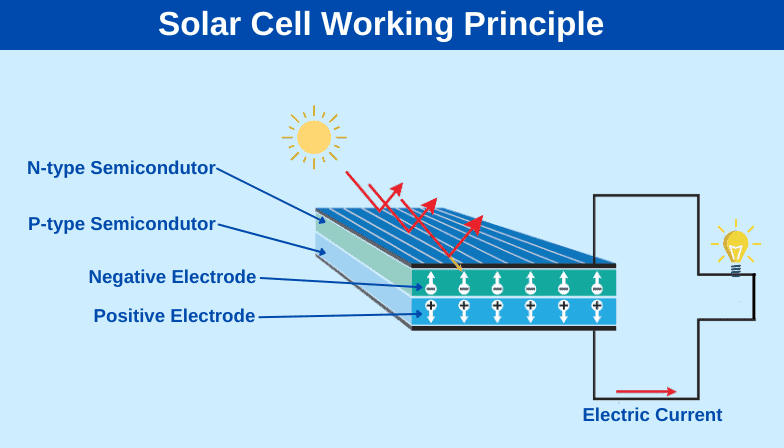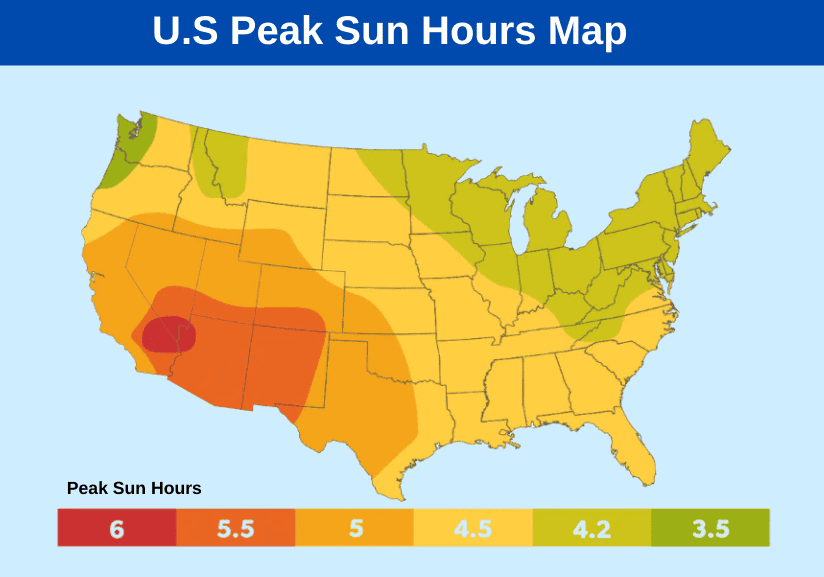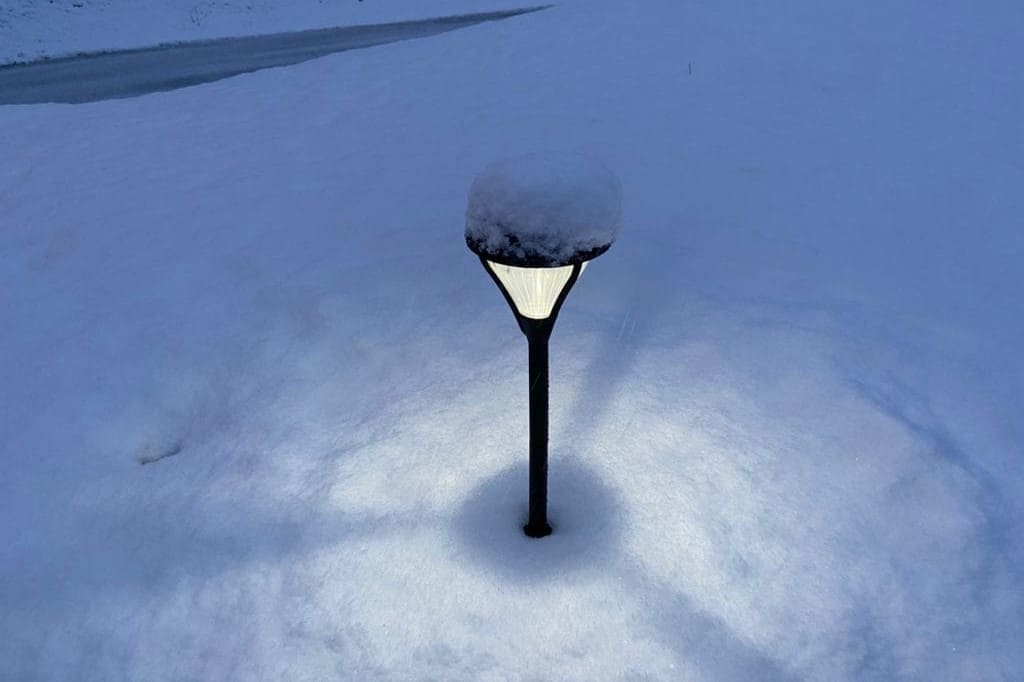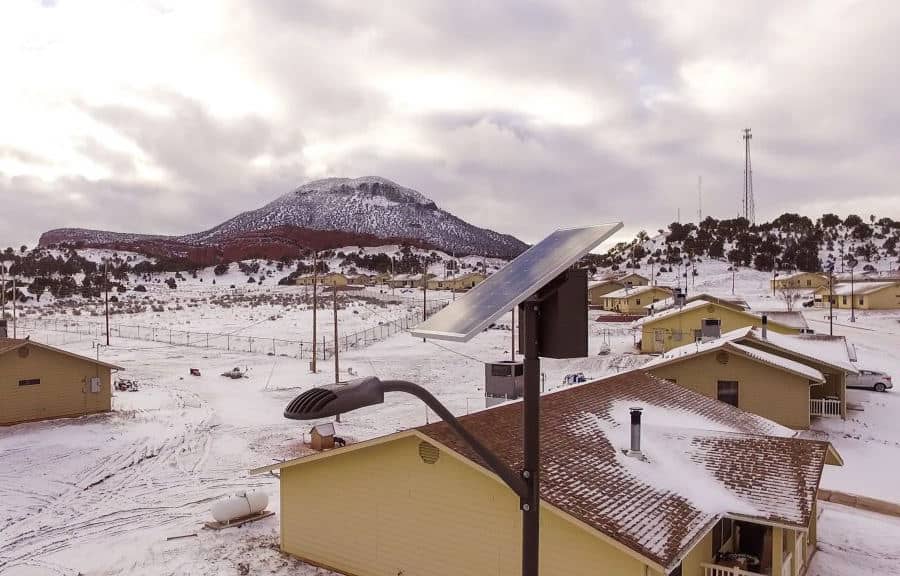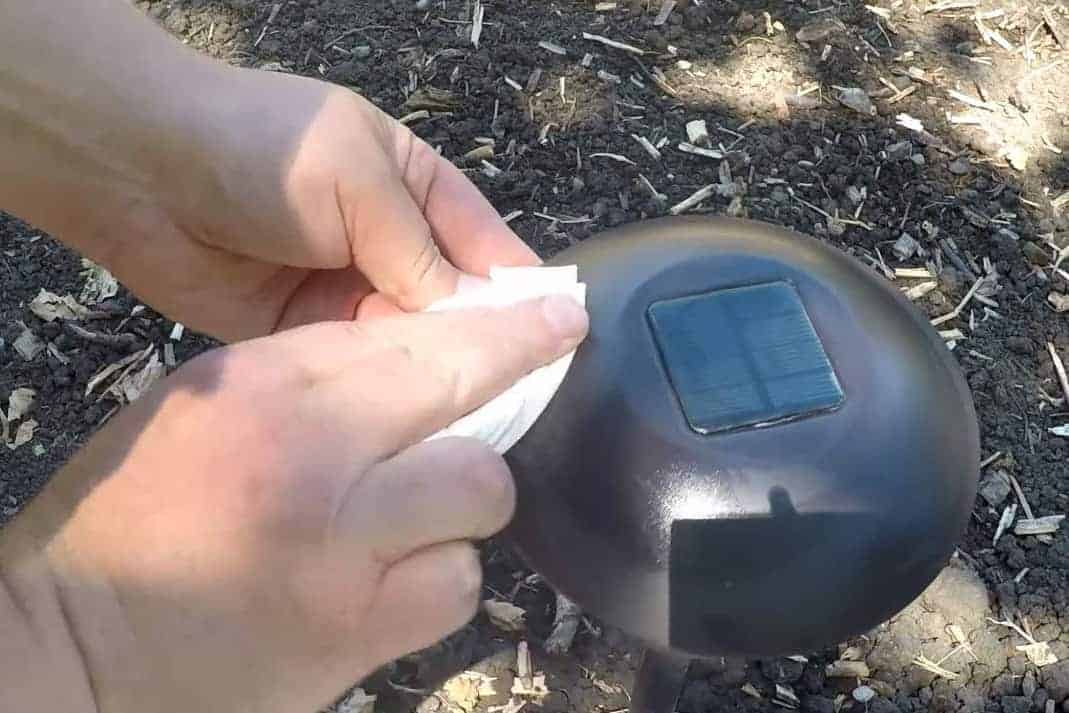I’ve been thinking of installing solar lights to light my home and garden at night. The idea of getting nightlights powered by free solar energy appeals to me; after all, free is a great price! But the problem is I live in a place with long, cold winters. So before I invest, I need to be sure that my solar lights will work in winter; otherwise, they won’t be of any use.
I researched some good information, but I couldn’t find anywhere that pulled all the available info together simply and understandably, so I decided to prepare one.
For all of you who have ever wondered, “Do solar lights work in winter” here is a complete and definitive answer.
How solar lights produce electricity from solar energy
To start, let’s have a very quick look at the process that converts solar energy into the electricity we use to power our lights. Solar lights contain a solar photovoltaic cell. This cell contains a semiconducting material, often silicon, that produces a chemical reaction when it comes into contact with sunlight. This chemical reaction releases charge-bearing particles called electrons which flow through a circuit as an electrical current.
Next, we transfer this electrical flow into a battery, where it is stored as chemical potential energy. Then at night, another light sensor called a photocell allows power to flow through a circuit containing an LED light, and our light burns throughout the night until daylight again figures the photocell and the light turns off.
Can solar lights store solar energy on cloudy days?
It’s a common misperception that solar cells can only collect the sun’s energy through direct sunlight. This isn’t the case, and even on cloudy, rainy, and even snowy days, the solar cell in your garden light continues to convert solar energy into electricity and store it in the battery.
The diagram below shows how solar cells generate power from direct sunlight and also from diffuse irradiation (sunlight.) The blue-colored diffuse sunlight charges the solar cell during daylight hours even when there is no direct sunshine.
Under cloudy conditions, a solar cell still produces energy from the sun.
The diagram for a cloudy summer day is particularly interesting because it shows that even though there is almost no direct sunlight, diffuse sunlight still generates plenty of energy. This is also the case in winter, so even on cloudy winter days, solar energy continues to power the solar cell.
The question isn’t whether your solar cells generate power in winter. (they can and do); it’s can they generate enough energy to power your solar lights on those long winter nights? Let’s find out.
How long does it take to charge a solar light fully?
The specifications of solar lights differ, but typically, a solar light needs around six to eight hours of direct sunlight to charge its battery fully. The solar light will operate for about four to six nights on a fully charged battery.
How much direct sunlight do different locations receive?
We measure the sunlight received by different places in peak solar hours. Daily peak sunlight hours vary from below four in the North to around six in the Southwest’s hottest states.
It’s important to note that these peak solar hours numbers are an annual daily average. So, somewhere like Maine, with an average of around four hours of daily peak sunlight hours, could have a winter average of two or three peak solar hours and then five or six hours in summer.
So there may be times, especially in cloudy northern states when it will be difficult to get enough sunlight to charge our solar lights.
But don’t worry, there are lots you can do to help your lights get the sunlight energy they need to work.
Solar cells work most efficiently in cold temperatures
It’s ironic, but solar cells don’t work as well when they get too hot. Commercial solar panels are tested at temperatures of 77°F, and their performance deteriorates at temperatures hotter than this. All electronic equipment prefers cool and cold temperatures, and this is the case with your solar lights. So don’t worry about cold temperatures impairing their performance because this isn’t an issue.
How to get the best performance from your solar lights in winter
Here are some practical and straightforward steps you should take to ensure that you get the best performance from your solar lights during the winter months.
Buy lights designed for winter conditions
Some solar lights are specially designed to work in places that don’t receive much sunlight in winter. These lights contain special features like a power-saving mode that automatically reduces their brightness times when the battery isn’t receiving much charge, so they last longer.
While dimmer lights are a perfect solution, it’s far preferable to all of your lights going off and leaving you in the dark. So shopping around for the right brand and model of light for your conditions is a must.
Location, location, location
When you install solar lights, you’re looking for locations that receive plenty of direct sunlight. Ideally, you want to place them somewhere where they get an uninterrupted view of the sun as it passes through the sky from sunrise to sunset. In practice, this is rarely possible, but it’s a good guiding principle.
But, whenever you install your solar lights, you need to remember that the sun is in a different place at different times of the year. Here in the northern hemisphere, the sum typically tracks across the southern sky, so we are looking for a position that offers maximum exposure facing south.
But in winter, the sun is further to the south and lower in the sky. It needs to pass through more atmosphere to reach our lights and, most importantly, it throws long shadows. When you look at how much sunlight your solar lights receive, be sure to check them in different seasons particularly in winter, to make sure that surrounding buildings, vegetation, and the like aren’t obscuring the lights from the sun.
Tilt solar panels
Depending on the type of solar light you purchase, it may be possible to tilt the solar cell’s angle to generate maximum power. If this is possible, then you should tilt the panel towards the south so that it is as perpendicular to the sun as possible.
But tilting the panel has another benefit because snow, dirt, and other objects will slide off the solar cell, ensuring that nothing obstructs its view of the sun.
Recommended to read: Find the Best Angle for Your Solar Panels
Charge solar lights using other energy sources
Okay, we know that solar lights are charged by the sun; after all, it’s in the name. But did you know that you can also charge solar lights using other energy sources? [How To Charge Solar Lights Without Sun?]
You can use regular bulb lights or LED lights in your home to charge your outdoor solar lights. This is an excellent option for portable or easily movable outdoor lights since you can bring them indoors during the darkest days and leave them under a direct bulb, and they will charge.
Solar lights don’t charge as effectively under artificial lighting as they do in direct sunlight. Still, it’s better than nothing, and this is a good thing to try if natural light isn’t giving your solar lights enough power to work effectively.
Keep your solar lights clear and clean
Clean solar light is a healthy solar light. Check and clean your solar lights, paying particular attention to the transparent cover Protecting the solar cell and photocell. Where necessary, clean the surface with a soft sponge and mild detergent. If the cell covering has become cloudy, then consider replacing it since this impairs performance.
Consider security lights or a mixture of security and regular lights
Security lights are an excellent night lighting option for your home in places that don’t see much sunlight in winter. You could add solar security lights in place of or in addition to your regular solar garden lights.
Security lights stay dark most of the time, but they have motion sensors that turn them on when they detect movement. Since security lights only work when needed, they can carry a charge and operate for a much longer time than regular nightlights.
Security lights are a great way to ensure that you have at least some night lighting during the winter months.
Pulling it all together
Even though solar lights carry enough power to work for several nights, it can be challenging to keep them working throughout the dark winter months, particularly in northern states. Solar cells don’t need direct sunlight to store energy, but some areas have higher average peak solar hours than others.
There are simple steps we can take to improve the performance of solar lights in the winter months
- Special solar lights with power-saving options are a good choice, as are motion-sensing spotlights.
- There’s plenty we can do to help our lights work year-round. We need to position them carefully to capture maximum sunlight and keep them clean to maximize their performance.
- Tilting solar panels towards the south keep surfaces clean and improve performance.
- We can charge solar lights using the lights in our homes.
If you have any comments or questions about how solar lights operate in winter conditions, then please share them with us here.


